Advertisements
Advertisements
Question
A rectangular metallic loop of length l and width b is placed coplanarly with a long wire carrying a current i (figure). The loop is moved perpendicular to the wire with a speed vin the plane containing the wire and the loop. Calculate the emf induced in the loop when the rear end of the loop is at a distance a from the wire. solve by using Faraday's law for the flux through the loop and also by replacing different segments with equivalent batteries.
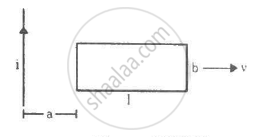
Solution
Consider an element of the loop of length dx at a distance x from the current-carrying wire.
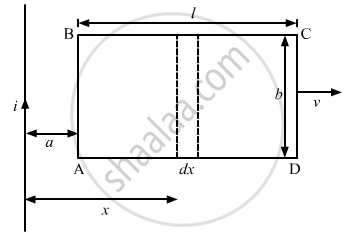
The magnetic field at a distance x from the the current-carrying wire is given by
\[B = \frac{\mu_0 i}{2\pi x}\]
Area of the loop = bdx
Magnetic flux through the loop element:-
\[d\phi = \frac{\mu_0 i}{2\pi x}bdx\]
The magnetic flux through the loop is calculated by integrating the above expression.
Thus, we have
\[\phi = \int\limits_a^{a + l} \frac{\mu_0 i}{2\pi x}bdx\]
\[ = \frac{\mu_0 i}{2\pi}b \int\limits_a^{a + l} \left( \frac{dx}{x} \right)\]
\[ = \frac{\mu_0 i}{2\pi x}\ln\left( \frac{a + l}{a} \right)\]
The emf can be calculated as:-
\[e = - \frac{d\phi}{dt} = \frac{d}{dt}\left[ \frac{\mu_0 ib}{2\pi}\log\left( \frac{a + l}{a} \right) \right]\]
\[ = - \frac{\mu_0 ib}{2\pi}\frac{a}{a + l}\left( \frac{va - (a + l) v}{a^2} \right) .............\left( \because \frac{da}{dt} = v \right)\]
\[ = \frac{\mu_0 ib}{2\pi}\frac{a}{a + l}\frac{vl}{a^2}\]
\[ = \frac{\mu_0 ib vl}{2\pi (a + l)a}\]
Calculation of the emf using the emf method:-
The emf. induced in AB and CD due to their motion in the magnetic field are opposite to each other.
The magnetic field at AB is given by
\[B_{AB} = \frac{\mu_0 i}{2\pi a}\]
Now,
Length = b
Velocity = v
The emf induced in AB is given by
\[e_{AB} = \frac{\mu_0 ivb}{2\pi a}\]
The magnetic field at CD is given by
\[B_{CD} = \frac{\mu_0 i}{2\pi (a + l)}\]
The emf induced in side CD is given by
\[e_{CD} = \frac{\mu_0 ibv}{2\pi (a + l)}\]
The net emf induced is given by
\[e_{net} = \frac{\mu_0 ibv}{2\pi a} - \frac{\mu_0 ibv}{2\pi (a + l)}\]
\[ = \frac{\mu_0 ibl(a + l) - \mu ibva}{2\pi a(a + l)}\]
\[ = \frac{\mu_0 ibvl}{2\pi a(a + l)}\]
APPEARS IN
RELATED QUESTIONS
A circular coil of radius 8.0 cm and 20 turns is rotated about its vertical diameter with an angular speed of 50 rad s−1 in a uniform horizontal magnetic field of magnitude 3.0 × 10−2 T. Obtain the maximum and average emf induced in the coil. If the coil forms a closed loop of resistance 10 Ω, calculate the maximum value of current in the coil. Calculate the average power loss due to Joule heating. Where does this power come from?
A jet plane is travelling towards west at a speed of 1800 km/h. What is the voltage difference developed between the ends of the wing having a span of 25 m, if the Earth’s magnetic field at the location has a magnitude of 5 × 10−4 T and the dip angle is 30°.
The closed loop (PQRS) of wire is moved into a uniform magnetic field at right angles to the plane of the paper as shown in the figure. Predict the direction of the induced current in the loop.
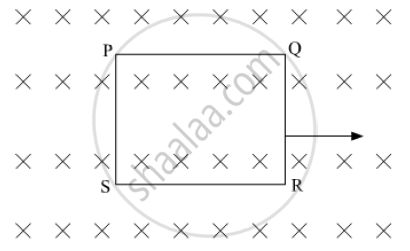
A .0.5m long solenoid of 10 turns/cm has area of cross-section 1cm2 . Calculate the voltage induced across its ends if the current in the solenoid is changed from 1A to 2A in 0.1s.
E°cell for the given redox reaction is 2.71V
\[\ce{Mg_{(s)} +Cu^{2+}_{(0.01 M)}->Mg^{2+}_{(0.001M)}+Cu_{(s)}}\]
Calculate Ecell for the reaction. Write the direction of flow of current when an external opposite potential applied is
(i) less than 2.71 V and
(ii) greater than 2.71 V
A 0⋅5 m long solenoid of 10 turns/cm has the area of cross-section 1 cm2. Calculate the voltage induced across its ends if the current in the solenoid is changed from 1 A to A in 0⋅1 s.
According to Faraday’s law of electromagnetic induction ______.
Faraday’s laws are consequence of the conservation of ______.
According to Faraday's law of electromagnetic induction, ______
A magnetic field in a certain region is given by `B = B_o cos (ωt)hatk` and a coil of radius a with resistance R is placed in the x-y plane with its centre at the origin in the magnetic field (Figure) . Find the magnitude and the direction of the current at (a, 0, 0) at t = π/2ω, t = π/ω and t = 3π/2ω.
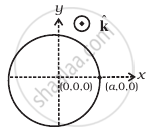
ODBAC is a fixed rectangular conductor of negilible resistance (CO is not connnected) and OP is a conductor which rotates clockwise with an angular velocity ω (Figure). The entire system is in a uniform magnetic field B whose direction is along the normal to the surface of the rectangular conductor ABDC. The conductor OP is in electric contact with ABDC. The rotating conductor has a resistance of λ per unit length. Find the current in the rotating conductor, as it rotates by 180°.
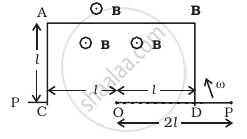
A magnetic field B is confined to a region r ≤ a and points out of the paper (the z-axis), r = 0 being the centre of the circular region. A charged ring (charge = Q) of radius b, b > a and mass m lies in the x-y plane with its centre at the origin. The ring is free to rotate and is at rest. The magnetic field is brought to zero in time ∆t. Find the angular velocity ω of the ring after the field vanishes.
The arm PQ of a rectangular conductor is moving from x = 0 to x = 2b outwards and then inwards from x = 2b to x = 0 as shown in the figure. A uniform magnetic field perpendicular to the plane is acting from x = 0 to x = b. Identify the graph showing the variation of different quantities with distance.

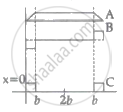
A square-shaped coil of side 10 cm, having 100 turns is placed perpendicular to a magnetic field which is increasing at 1 T/s. The induced emf in the coil is ______.
Two coils C1 and C2 are placed close to each other. The magnetic flux Φ2 linked with coil C2 varies with the current I1 flowing in coil C1 as shown in the figure. Find
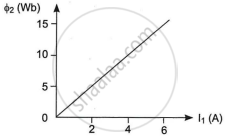
- The mutual inductance of the arrangement, and
- The rate of change of current `((dI_1)/(dt))` will induce an emf of 100V in coil C2.
How much charge in terms of Faraday is required for the reduction of 1 mol of Cu2+ to Cu?
